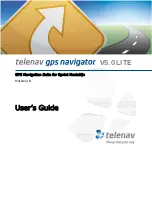
WEATHER DISPLAY INTERFACE
82005-PG-D
SANDEL SN3500 EHSI PILOT’S GUIDE
PAGE
7-7
conjunction with other information sources to support in-flight
decisions.
FIS-B information is to be used as a strategic planning tool for pilot
decisions on avoiding areas of inclement weather that are beyond
visual range of where poor visibility precludes visual acquisition of
inclement weather. FIS-B weather and NAS status information may
be used as follows:
•
To promote pilot awareness of own ship location with
respect to reported weather, including hazardous
meteorological conditions, and enhance decision-making
during strategic flight planning activities.
•
To cue the pilot to communicate with the Air Traffic Control
controller, Aircraft Flight Service station specialist, operator,
dispatch, or airline operations control center as required.
•
Figure 7-9 illustrates the FIS-B information flow from the NEXRAD
radar sites to the cockpit. The process flow begins with NEXRAD
radar observations taken and sent to the processing and uplink
facility. Depending on radar sweep rates and configuration, these
observations may be aged from 2 – 8 minutes when they enter the
processing facility.
Figure 7-9 FIS-B information flow
WEATHER DISPLAY INTERFACE
82005-PG-D
SANDEL SN3500 EHSI PILOT’S GUIDE
PAGE
7-8
The processing facility collects the NEXRAD information and builds
a set of mosaic tiles representing recent weather conditions. After
this information has been processed it is then up-linked to satellites
for retransmission to aircraft receivers. This process can take up to
3 minutes depending on the amount of information to be uplinked.
By the time this information is received in the aircraft and displayed
on the SN3500, it will be aged from 3 to 11 minutes depending on
the amount of data transmitted. This process is repeated at
approximately 5 minutes intervals.
Approximately every 5 minutes, a complete set of mosaic weather
tiles representing precipitation is transmitted to the aircraft. Flight
conditions and aircraft position/attitude may cause errors in the data
reception causing loss of 1 or more of the mosaic tiles. When this
occurs, the last tile(s) received will be displayed on the screen as
long as the reception age of the tile(s) is not older than 30 minutes
and the tile(s) is not older than 10 minutes from any other tile. Any
tile outside of these aging parameters are removed from the screen
and displayed as no data using a gray background. The reception
age uses the time the tile is received from the aircraft receiver by
the SN3500. The SN3500 displays to the right of the WX button the
time in minutes since any mosaic tiles have been received.
Examples
FIS-B weather information is provided without any reference to
altitude or flight level. Depending upon the current aircraft flight
level, it is very possible that the conditions observed visually or from
on-board weather radar displays may not correlate to the graphic
presentation on the SN3500. Figure 7-10 is a typical example of
precipitation displayed on the SN3500.
















































